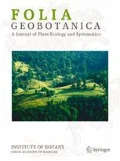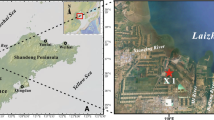Abstract
Sporopollenin layers in the cell wall of coccal green algae are responsible for the resistance of cell walls to destructive processes during fossilization as well as during chemical preparation of samples for pollen-analysis. Pollen slides of samples from limnic sediments thus also contain some algal cell walls. Although some pollen-analysts tried to stress this fact, the finds of algae in pollen slides have not been paid systematic attention yet, despite their potential use for a more accurate palaeoecological reconstruction.
The article summarizes the results of palaeoecological studies showing how the algae can be used in palaeoecological reconstruction of past environments. The possibility of utilizing the indicative value of algal finds is demonstrated on examples of algal communities from fossil, subrecent and recent sediments from different longitudes, latitudes, and altitudes. The identification and indicative values of species and varieties ofPediastrum are included in a special review (Komárek & Jankovská, Biblioth. Phycol., in press). The contemporary knowledge of ecological requirements of the given taxa, completed by information from their fossil finds, makes possible the reconstruction of trophic and temperature conditions and of the purity of the water environment of the past water biotopes.
Similar content being viewed by others
References
Alhonen P. &Ristiluoma S. (1973): On the occurrence of subfossilPediastrum algae in a Flandrian core at Kirkkonummi, southern Finland.Bull. Geol. Soc. Finland 45: 73–77.
Bottema S. (1974):Late-quarternary vegetation history of Northwestern Greece. PhD. thesis, Rijksuniv. Groningen, Groningen.
Crisman T.L. (1978): Algal remains in Minnesota lake types: a comparison of modern and Late-Glacial distributions.Int. Vereinigung Theor. Limnol. Verh. 20: 445–451.
Cronberg G. (1982a):Pediastrum andScenedesmus (Chlorococcales) in sediments from Lake Växsjösjön.Arch. Hydrobiol/Algol. Stud. 29: 500–507.
Cronberg G. (1982b): Phytoplankton changes in Lake Trummen induced by restoration.Folia Limnol. Scand. 18.
Fjerdingstad E. (1954): The subfossil algal flora of the lake Bølling Sø and its limnological interpretation.Kong. Danske Vidensk. Selsk., Biol. Skr. 7(6): 1–56.
Fredskild B. (1973): Studies in the vegetational history of Greenland: palaeobotanical investigations of some holocene lake and bog deposits.Meddel. Grønland 198: 1–245.
Grosjean M., van Leeuwen J.F.N., van der Knaap W.O., Geyh M.A., Ammann B., Tanner W., Messerli B. & Veit H. (in press): A 22.000 14C yr BP sediment and pollen record of climate change from Laguna Miscanti 23S, northern Chile.Global Planet. Change.
Guy-Ohlson D. (1992):Botryococcus as an aid in the interpretation of palaeoenvironment and depositional processes.Rev. Palaeobot. Palynol. 71: 1–15.
Haas J.N. (1994): First identification key for charophyte oospores from central Europe.Eur. J. Phycol. 29: 227–235.
Jankovská V. (1970): Ergebnisse der Pollen- und Großrestanalyse des Moores ‘Velanská cesta” in Südböhmen.Folia Geobot. Phytotax. 5: 43–60.
Jankovská V. (1980):Paläogeobotanische Rekonstruktion der Vegetationsentwicklung im Becken Třeboňská pánev während des Spätglazials und Holozäns. Vegetace ČSSR, A 11, Academia, Praha.
Jankovská V. (1983): Palynologische Forschung am ehemaligen Komořany-See (Spätglazial bis Subatlantikum).Věstn. Ústř. Ústavu Geol. 58/2: 99–107.
Jankovská V. (1988): Palynologische Erforschung archäologischer Proben aus dem Komořanské jezero-See bei Most (NW-Böhmen).Folia Geobot. Phytotax. 23: 45–77.
Jankovská V. (1989): The evolution of Late-Glacial and Holocene vegetation in the vicinity of Světlá nad Sázavou (in the Western Forland of the Bohemian-Moravian Uplands).Folia Geobot. Phytotax. 24: 337–448.
Jankovská V. &Komárek J. (1982): Das Vorkommen einiger Chlorokokkalalgen im böhmischen Spätglazial und Postglazial.Folia Geobot. Phytotax. 17: 165–195.
Jankovská V. &Komárek J. (1992): Importance of subfossil green coccal algae for palaeoecological reconstruction (Late-Glacial-Holocene). In:Pons A. (ed.),Program and abstracts of the 8th International Palynological Congress, Aix-en-Provence, Sept. 6–12, 1992, Aix-Marseille III University, Aix-en-Provence, p. 72.
Jankovská V. &Komárek J. (1995):Pediastrum orientale from subfossil layers.Folia Geobot. Phytotax. 30: 319–329.
Jankovská V. &Panova N.K. (1998): Late Glacial and Holocene history of Vegetation in Polar Ural region, Russia. In:Wacnik A. (ed.),Abstract of the 5th European Palaeobotanical and Palynological Conference, Cracow, June 26–30, 1998, W. Szafer Institute of Botany, Polish Academy of Sciences, Cracow, p. 84
Jankovská V. & Pokorný J. (in press): Palaeoecology of a Medieval fishpond system (Vajgar, Czech Republic).Arch. Hydrobiol./Algol. Stud.
Jankovská V., Vasari Y., Elina G.A. &Kuznetsov O.L. (1999): The Holocene palaeogeography of Paanajärvi National Park, northwestern Russia.Fennia 177/1: 71–82.
Janssen C.R. (1986): Myrtle Lake: A Late and Postglacial pollen diagram from northern Minnesota.Canad. J. Bot. 46: 1394–1408.
Komárek J. &Fott B. (1983):Chlorophyceae (Grünalgen), OrdungChlorococcales. In:Huber-Pestalozzi G. (ed.),Das Phytoplankton des Süsswassers, Die Binnengewässer 16, 7/1, E. Schweizerbart’sche Verlagsbuchhandlung, Stuttgart.
Komárek J. & Jankovská V. (in press): Review of the green algal genusPediastrum; Implication for pollen-analytical research.Biblioth. Phycol.
Komárek J. &Marvan P. (1992): Morphological differences in natural populations of the genusBotryococcus (Chlorophyceae).Arch. Protistenk. 141: 65–100.
Lotter A.F., Birks H.J.B., Hofmann W. &Marchetto A. (1997): Modern diatom, cladocera, chironomid, and chrysophyte cyst assemblages as quantitative indicators for the reconstruction of past environmental conditions in the Alps. I. Climate.J. Paleolimnol. 18: 395–420.
Makohonienko M. (1997): Subfosylne znalaziskaChlorophyta, Cyanobacteria iNematoda w osadach limnicznych środkowej Wielkopolski jako wskażniki pradziejowych i wczesno-historycznych oddziaływań antropogenicznych na ekosystemy jeziorne (Subfossil finds ofChlorophyta, Cyanobacteria andNematoda in the limnic sediments of central Poland as indicators of prehistoric and Early Middle Ages human activity on lake ecosystems). In:Choiński A. (ed.),Wpływ antropopresji na jeziora (Human impact on lakes), Materials from the conference, Poznań, 2.12.1997, Homini, Poznań-Bydgoszcz, p. 101–111.
Marchetto A. (1995):Light- and electron microscopic evaluation of chrysophycean remains in surface samples of 62 lakes in the Alps and establishing a calibration set for environmental variables transfer functions. Report Österreichische Akademie der Wissenschaften, Institut für Limnologie, Mondsee.
Nielsen H. &Sørensen I. (1992): Taxonomy and stratigraphy of Late-GlacialPediastrum taxa from Lysmosen, Denmark — a preliminary study.Rev. Palaeobot. Palynol. 74: 55–75.
Panova N.K. (1982): Istoriya gornykh lesov tsentral’noi chasti yuzhnogo Urala v golotsene (History of mountain forests in the central part of Southern Urals in Holocene).Lesovedenie 1: 26–34.
Pidek I.A. (1998): The Ferdynandów interglacial at Zdany near Siedlec (Central Eastern Poland). In:Wacnik A. (ed.),Abstract of the 5th European Palaeobotanical and Palynological Conference, Cracow, June 26–30, 1998, W. Szafer Institute of Botany, Polish Academy of Sciences, Cracow, p. 139.
Sebestyén O. (1968):Pediastrum kawraiskyi Schmidle (Chlorophyta, Protococcales) in the sediments of Lake Balaton.Ann. Biol. (Tihany) 35: 200–226.
Sebestyén O. (1969): Studies onPediastrum and Cladoceran remains in the sediments of Lake Balaton with reference for lake history.Mitt. Int. Vereinigung Theor. Angew. Limnol. 17: 292–300.
van der Knaap W.O., van Leeuwen J.F.N., Fankhauser A. & Ammann B. (in press): Palyno-stratigraphy of the last centuries in Switzerland based on 23 lake and mire deposits: chronostratigraphic pollen markers, regional patterns, and local histories.Rev. Palaeobot. Palynol.
van Geel B. (1976): Fossil spores ofZygnemataceae in ditches of a prehistoric settlement in Hoogkarpsel (The Netherlands).Rev. Palaeobot. Palynol. 22: 337–344.
van Geel B. &van der Hammen T. (1978):Zygnemataceae in Quaternary Colombian sediments.Rev. Palaeobot. Palynol. 25: 377–392.
van Geel B., Mur L.R., Ralska-Jasiewiczowa M. &Goslar T. (1994): Fossil akinetes ofAphanizomenon andAnabaena as indicators for medieval phosphate-eutrophication of Lake Gosciaz (Central Poland).Rev. Palaeobot. Palynol. 83: 97–105.
Winter M. (1993):Pollenanalytische Untersuchung in Wauwilermoos, Kanton Luzern, Schweiz. MSc. Thesis, Albert-Ludwig-Universität, Freiburg im Breisgau.
Author information
Authors and Affiliations
Corresponding author
Rights and permissions
About this article
Cite this article
Jankovská, V., Komárek, J. Indicative value ofPediastrum and other coccal green algae in palaeoecology. Folia Geobot 35, 59–82 (2000). https://doi.org/10.1007/BF02803087
Received:
Revised:
Accepted:
Issue Date:
DOI: https://doi.org/10.1007/BF02803087




